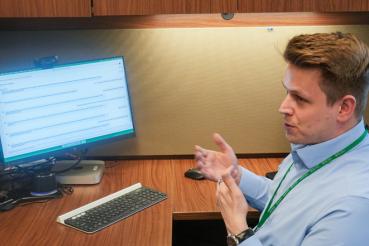If you've been diagnosed with myasthenia gravis, you may already know that that this neuromuscular condition does not follow the same path for each person. Often referred to as "the snowflake disease," myasthenia gravis, or MG, affects each person differently and likewise, treatment must be individualized.
Myasthenia gravis is an autoimmune disease characterized by muscle weakness of the voluntary muscles. The more these muscles are used, the more they weaken. That means everyday activities such as keeping your eyes open, holding up your head or using your arms for overhead activities can become challenging by the end of the day.
Here, Madhu Soni, MD, a neuromuscular expert at Rush, offers perspectives on what someone living with myasthenia gravis should know, along with the following tips.
1. Work with your doctor to keep your MG under control.
When people first get diagnosed with myasthenia gravis, they often think it’s going to prevent them from living a full life.
"Myasthenia is a very treatable condition," Soni emphasizes. "The specific treatment course can vary between people and take time to reach. Adjustments may also need to be made with certain activities, but the goal is to have everyone live a full, functional life."
Regular follow-up and communication with your doctor is one of the best ways to find the right treatment regimen for you. The process will often require frequent discussion with your doctor to determine which medicines — and doses — are right for keeping both your MG and any medication side effects under control.
2. Study your body.
Because each person's myasthenia may not affect them in the exact same way, it's critical to keep track of how you feel throughout the day — both for your sake and to help your doctor tailor your treatment.
This tracking includes the following:
- Make note of which symptoms you are experiencing, what time of day they occur and how long they last. Record which activities you are doing when your symptoms appear to try to identify triggers.
- Jot down which time of day you feel strongest, and during which activities.
- Record all your medicines and their doses; if and when you feel the medicine kick in or wear off; and any side effects.
3. Know when to get a second opinion.
Myasthenia gravis can be challenging to diagnose, particularly if blood tests for the acetylcholine receptor (AChR) and muscle specific tyrosine kinase (MuSK) antibodies are negative, according to Soni.
"A second opinion can help both with confirming the diagnosis and ensuring the best individual treatment approach," Soni adds. "In some cases, your physician may not be as comfortable or familiar with a particular medication, and therefore may not consider that medication as an option for you.
For reasons such as these, Soni and her colleagues frequently see patients seeking a second opinion.
4. Exercise with caution.
As you would expect, exercise is tricky with MG. The ideal exercise program helps you maintain muscle strength and overall endurance, without expending too much energy and causing fatigue that may limit your ability to engage in other activities.
Here are a few tips for exercising with caution, according to Conquer MG (formerly known as the Myasthenia Gravis Foundation of Illinois):
- Start slowly and with guidance from your health care provider.
- Exercise in short lengths of time and only to moderate intensity.
- Exercise at your best time of day. From your experience, look for the times when you are strongest, your symptoms are less prominent and your medication is at its peak effect. Don't exercise if you are experiencing weakness.
- Focus on the proximal muscles. These are the muscles closest to the trunk of your body and are also referred to as your "limb girdle" muscles. Recumbent stationary bicycles or elliptical machines with stationary arms and non-skid foot panels (for stability) are two good choices of equipment for working these muscles safely if your doctor approves.
5. Look for ways to save your energy.
Conquer MG offers a helpful rundown of all the ways in which you can conserve energy throughout the day. Here are a few ideas:
- Get help with daily tasks: There are lots of tools available to help you perform everyday tasks more easily. For example, use an electric rather than manual can opener, mixer and toothbrush; use lightweight silverware and plastic dishes rather than heavier ones; and if you need to blowdry your hair, consider a countertop blow-dryer instead of a handheld.
- Rest when you need to: Listen to your body when it tells you to slow down and stop for a while.Build naps into your day without feeling guilty. Rest your eyes regularly while working on electronic devices or reading.
- Sit down whenever possible: For instance, sit rather than stand in the shower, while brushing your teeth or shaving, and make use of available scooters while shopping.
- Minimize distances: If you don't already have one, apply for a handicap car sticker so you can park closer to stores. Place items that you frequently need within reach, rather than in places that force you to reach up, bend down or get down onto the floor.
6. Talk to your doctor about whether immunosuppressive or anticholinesterase medications are right for your form of MG.
Since the type of MG, symptoms and experience with the condition may vary from person to person, treatment must be individually tailored. The available treatment options work in different ways.
"Pyridostigmine (also known by its brand name Mestinon), is an anticholinesterase medication. It helps temporarily with symptoms in most patients with MG. However, those with the MuSK antibody may be more sensitive to the medication and not tolerate it well," explains Soni. "In addition, anticholinesterase medication does not target the underlying immune problem in MG. For those with more than mild symptoms, immunosuppressive therapy is generally needed."
We closely monitor our patients for side effects, and we try to identify the lowest dose of medication needed to get their myasthenia under control.
7. Find out whether thymectomy is an option for you.
For people with MG who have thymomas (tumors of the thymus gland) that are evident through imaging tests, thymectomy (removal of the thymus) is recommended.
Results from an international, multicenter study published in the New England Journal of Medicine in 2016 showed that even in a specific population of AChR antibody positive MG patients without a thymoma, thymectomy showed a benefit in reducing symptoms, medication requirements and the need for hospitalization to manage exacerbations, Soni reports.
8. Pay attention to medication side effects.
"Each medication has its own side effect profile, even over the counter medications. Being familiar with the possible side effects, taking the appropriate precautions and reporting any new symptoms are all part of the management of myasthenia," Soni says. "We closely monitor our patients for side effects, and we try to identify the lowest dose of medication needed to get their myasthenia under control."
As noted earlier, regular communication and follow-up allows your doctor to find the right combination of medication to manage the myasthenia while minimizing side effects.
9. Address your nutritional needs and swallowing considerations.
Prednisone — a steroid medication frequently used to treat for MG — can cause increased appetite and weight gain. Soni and her colleagues, therefore encourage patients to meet with a dietitian who specializes in helping people maintain a well-balanced diet and educating them on low-carbohydrate, high-protein foods.
In addition, people with MG may find that muscle weakness in their jaws, throat and lips, jaws and throat can affect their ability to chew or swallow. The good news, according to Soni, is that once people with MG find their optimum treatment regimen, these symptoms tend to improve.
Here are a few tips that can help at mealtime:
- Eat several small meals throughout the day rather than big meals that can cause your muscles to tire during the course of chewing and swallowing.
- Chop or mince solid foods.
- Take small bites of food to avoid taxing your jaws and throat.
- Avoid hot liquids that can potentially relax the throat muscles.
- If you are on anticholinesterase medication, take it 30-45 minutes before mealtime, to optimize the strength of the mouth and throat muscles.
10. Invest in stress management.
Like it does with many conditions, stress can trigger or worsen your myasthenia symptoms. Although it’s often easier said than done, try to look for ways to effectively manage your stress, such as regular meditation (e.g., through a mindfulness-based stress reduction program), recreational/inspirational reading, listening to music and, if possible, regular low-impact exercise.
Remember to let your doctor know if you are having trouble managing stress. He or she can refer you to a professional who can help you find effective methods of stress reduction that work best for you.
11. Recognize when it’s an emergency.
Despite your and your doctor’s best efforts, you may still experience a myasthenic crisis. The most common triggers for a crisis are too rapid medication withdrawal or issues that really stress your system, like surgery, an infection or other illness.
During a crisis you may have severe breathing or swallowing difficulties to the point that you require ventilation or intubation. If your weakness worsens rapidly, call your doctor immediately. If you are unable to reach your doctor, or if your breathing or swallowing problems are severe, call 911.




